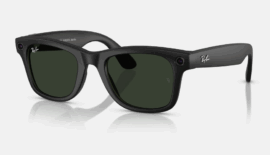Blog
The Future Looks Bright With Ray-Ban Meta Smart Glasses
Posted by: Invision Optometry in Category Fine Eyewear

We’ve all had that moment: you’re out on a walk, the lighting is perfect, and you think, “I wish I could snap a photo without fumbling for my phone.” Or maybe you’re deep into a podcast while running errands and you miss a text. Enter the Ray-Ban Meta smart glasses—your new favorite way to stay… Read More
FACE A FACE Eyewear: Art for Your Eyes
Posted by: Invision Optometry in Category Fine Eyewear

Have you ever looked at a pair of glasses and thought, “Now that is a work of art”? FACE A FACE eyewear isn’t just about great vision—it’s also about self-expression. Your eyewear should feel like a natural extension of your personality, making a statement without saying a word. That’s exactly what FACE A FACE eyewear… Read More
Blackfin Eyewear: Precision, Craftsmanship, and Effortless Style
Posted by: Invision Optometry in Category Fine Eyewear

If you’ve ever put on a pair of high-quality glasses and immediately felt like they were made just for you—lightweight, perfectly balanced, and stylish without trying too hard—then you already understand what makes Blackfin Eyewear special. These frames aren’t just another pair of designer glasses; they’re a statement about what happens when premium materials meet… Read More
Discover How Ørgreen Eyewear Transforms Your Vision and Style
Posted by: Invision Optometry in Category Fine Eyewear

You probably don’t think much about your glasses—after all, they’re just something to help you see, right? But what if your glasses could be more than that? What if they could make you feel more confident, comfortable, and stylish every day? That’s where Ørgreen comes in. Eyewear That Actually Feels Good to Wear We’ve all… Read More
Are Your Progressive Lenses Putting You at Risk? Here’s What You Need to Know
Posted by: Invision Optometry in Category Lenses, Progressive Lenses

As we age, maintaining clear and stable vision becomes even more important for our overall safety. Progressive lenses offer a seamless way to see at multiple distances, but as Peter Perl’s AARP article, The Hidden Danger of Progressive Lenses highlights, the wrong pair can increase your risk of dizziness, disorientation, and even dangerous falls. That’s… Read More
What’s the Difference Between Myopia and Astigmatism?
Posted by: Invision Optometry in Category Astigmatism, Eye Health, Myopia Control

When it comes to vision problems, terms like myopia (near-sightedness) and astigmatism can be confusing. Are they the same thing? Do they both mean you need glasses? Let’s break down the difference between these two common eye conditions, so the next time you hear them, you’ll know exactly what they mean and how they affect… Read More
Are Myopia & Astigmatism the Same Thing? What Parents Need to Know
Posted by: Invision Optometry in Category Myopia Control

As a parent, there’s nothing more important than your child’s health—and that includes their vision. If they’ve been diagnosed with myopia (near-sightedness) or astigmatism, you might be wondering what these terms mean and how they affect your child’s everyday life. Don’t worry, we’re here to help make things clearer (pun intended)! Myopia: Why Your Child… Read More
How to Get the Eye Care You Deserve Without Breaking the Bank
Posted by: Invision Optometry in Category Affordable Eye Care

Financial Worries Imagine this: You’ve just had your eye exam and found the perfect contact lenses/pair of glasses that make you feel confident and stylish. However, you’re feeling the pinch of the current economy and are worried that you’ll have to walk out without getting the eye care and eyewear that you deserve. What do… Read More
Answers To Your Dry Eye Questions!
Posted by: Invision Optometry in Category Dry Eye Management

Today, let’s delve into the world of dry eye and address some common questions that many of us may have about this often bothersome condition. Whether you’ve experienced it firsthand or know someone who has, you’re in the right place to learn more about this common yet manageable condition. What Is Dry Eye? Essentially, it’s… Read More
Your Eyes at Every Age: A Friendly Guide to Vision Changes
Posted by: Invision Optometry in Category Eye Health

Today, let’s take a stroll through the various stages of life and explore how our vision evolves over time. Our eyes, like faithful companions, are with us every step of the way, which is why it’s essential to understand how they change as we age. So, let’s uncover some common eye conditions and topics to… Read More


